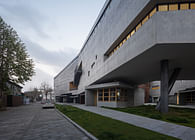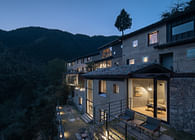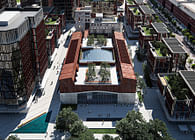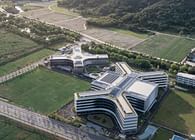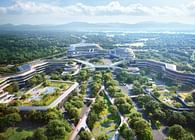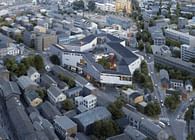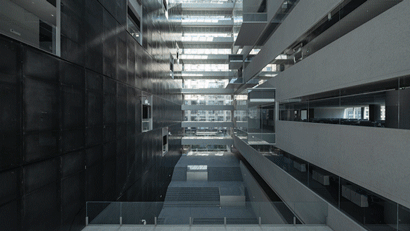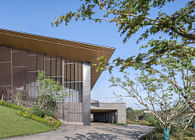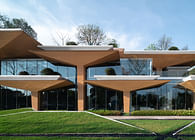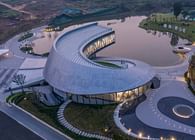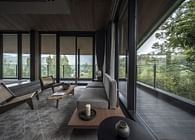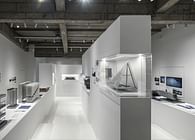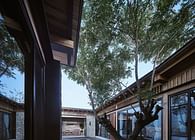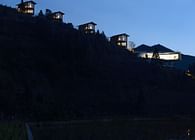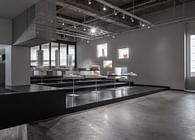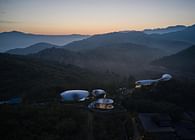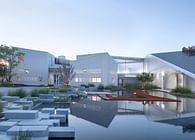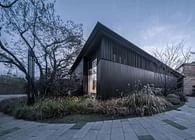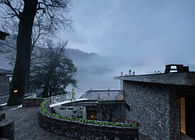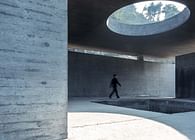
In the last century, the urban development of Hangzhou concentrated and grew around the single center of the West Lake. Since the new century, the urban construction of Hangzhou has been moving southward along the canal system. With the continuous formation of the multi-center urban structure, Hangzhou has been formally moving toward the “Qiantang River Era” from the “West Lake Era” which has been lasting for thousands of years. Both banks of the Qiantang River are rising with unprecedented energy, endowing the culture of Hangzhou with a new spiritual core.
The Qiantang River Museum is located at the confluence of the Beijing-Hangzhou Grand Canal and the Qiantang River, overlooking the rivers joining the sea, and the Century Lotus, the main stadium of the 2022 Asian Games. Located at the geographic confluence of Hangzhou’s most important rivers, the project shoulders the responsibility of presenting and disseminating Hangzhou's next candidate project for the world cultural heritage to the world.
line+ won the design right of the project through an international competition in July 2018. After 15 months of repeated demonstrations and deepening of the design, the project officially started construction on December 18, 2019, and the civil construction part is expected to be completed by the end of 2021.
The location of the Qiantang River Museum has both the importance and sensitivity of geographical location and historical significance.
Geographically, the site is located at the southern end of the Beijing-Hangzhou Grand Canal, a world cultural heritage, where the two major river systems of Hangzhou, the Beijing-Hangzhou Grand Canal and the Qiantang River, converge. The Grand Canal which was built in the Spring and Autumn period, flows through the beautiful land of the rich and refined Qiantang, recording the vicissitudes of the prosperous ancient capital and the various lifestyles in the city. The Qiantang River, anciently known as “Zhejiang”, is not only the largest river in Zhejiang Province, but also the origin of the name of Zhejiang province. As one of the birthplaces of Wuyue culture, Qiantang River overlooks the southeast and has experienced through the past and the present. At the confluence of the civilizations of the two major river systems, the museum is a well-represented landmark of Hangzhou's “water” culture.
In terms of the historical significance, the project is located at the junction of phase I and phase II of Qianjiang New City in the Hangzhou CBD, adjacent to the north side of the project site, and across the Grand Canal, there is the planned urban complex of Jianghehui. In the future, it will become an important urban commercial and residential landmark in the center area of Hangzhou. Besides, the main stadium of the 2022 Hangzhou Asian Games is just across the river. Hangzhou's past, present and future also meet here.
"At the confluence of rivers and the occasion of the replacement of the old and the new, in the face of a city's past and present, we have jumped out of the temptation of symbolism and monuments, reshaped the flow of people in a more straightforward way, inspired more behavior possibilities, and provided open, cordial and participatory places for the participants of urban public life, which is our design goal and pursuit."
——Zhu Peidong, Chief Architect of gad • line+ studio
The project is faced with multiple challenges. On the one hand, it is a city location of wide concern. On the other hand, there are harsh planning conditions: a base area of 3386㎡, the planning height limit of 24 meters, a construction requirement of 12,000 square meters, as well as the diversified display demands.
In the face of the sensitivity and complexity of the project, the design team chose to participate in it actively but with cautious.
First, 2/3 of the venue volume is designed to be underground in order to balance the conflict between the height requirement of the exhibition hall, the planning height limit and the construction scale. Due to the altitude difference between the Qiantang River Trail and the project terrain, the flows at the visit entrance and the service entrance are separated.
Secondly, the construction of the museum, a venue with strong public attributes, at the intersection of the two waterfront public spaces in Hangzhou, the Canal Trail and the Riverside Walkway, inspired line+ architects to further strengthen their public attributes.
In order to actively satisfy the demands of the city, the line+ puts forward the concept of “public space return rate”, that is, the museum is defined as a new type of full-time public space. The museum not only performs its functions during the operation hours in daytime, but also becomes an organic component of urban public space and an important carrier of citizens’ public activities after closing at night, making it more valuable due to multiple uses of time and space.
Through the extension of the trail around the site and the design of the architectural body, the four streams of people that may meet here- museum visitors, business customers in Jianghehui, canal tour walkers, Qianjiang New City Riverside walkers, can be guided to the roof of the museum at a height of 24 meters through the upward spiral public trail. People are encouraged to explore the visual experiences of the urban landscape in different spatial heights and dimensions, through the spacial elevation and vision expansion.
Due to limited construction space, a spiral and interweaving architecture with the shape of the inverted frustum of a cone, bigger in top and smaller in bottom, is designed, with two groups of flows inside and outside the museum, leaving sufficient public space and roundabouts for the ground floor. Meanwhile, it’s like multiple streams of water swirling and intertwining up visually, enhancing the building’s identifiability of born in water.
Through upward spiral trails, multiple streams of people with different purposes will eventually converge on the roof of the Qiantang River Museum. The large-scale cantilevered viewing platform has become a symbol of the infinite extension of the city's public space. The public attributes of the museum are also further promoted.
—Narrative Space—
A unique narrative language is implied in the interior and exterior space design of Qiantang River Museum. In architecture, the architect constructs the spatial narratives with architectural techniques, and designs the visitors’ viewing experience, so as to resonate with the historical inheritance carried by Qiantang River within a limited space.
The architects, considering the flow directions of people, try to make some guiding adjustments to the urban landscape on the site lower than the height of the embankment as the intersection and extension of the riverside trail and canal green corridor, to have a natural elevation of the site with a grassy slope, shaping a new path connecting the riverside and the building.
The crisscrossing external corridors constitute an upward spiral path, guiding the visitors upstairs to the river view platform of the roof garden to experience the panoramic landscape. Inside the building, part of the display functions are designed in the underground, to meet the exhibition demand within limited land and the requirements of floor area ratio, and the flow spirals up from the ground floor to the third floor, viewing the circuitous history journey of Qiantang River to the foreseeable future.
The flow of people inside and outside the museum, resting and stopping in the museum, is a dramatic scene in the moment when the vision converges. At the end of the visit, the visitors themselves, together with the museum, have become part of the Qiantang River’s historical evolution memory community.
— Facade Language —
The spiral corridor in the architectural modeling directly reflects the real logic of the design concept, while the facade language is inspired by the modular pond construction approach of five-vertical and five-horizontal in the ancient seawall of Qiantang River.
With the help of modern digital technology and the unit-type titanium zinc panel curtain wall crisscrossing “masonry”, the unit-type titanium zinc panel curtain walls with different sizes of convex, concave or flat constitute a series of facade texture changes around the building surface, shimmering like water waves under different lights, which also reflects the interpretation of Wang Anshi’s “the wave, is the skin of water”.
line+ have a deep control of the curtain wall unit, through the integrated design of facade, curtain wall, and the lighting. With the small dislocation between the unit and the unit, the night lighting is effectively hidden, and meanwhile, a multi-level visual texture is formed.
At night, the curtain wall is covered with waves of light and shadow. In the grand space along the river, the soft and quiet brilliance is sprinkled, which makes the museum a potential new urban public landmark at the convergence of Qiantang River and Grand Canal.
— Remarks —
As the bridgehead of Hangzhou’s transition to “supporting the development along the river”, the Qiantang River Museum, in an open, sharing and inclusive manner, will endow the place with a richer and more public spirit. In the context of a contemporary city with diverse values, we encourage the museum to take the initiative: this is not only the geographic convergence of rivers, but also the spatial convergence of different people and cultural activities, as well as the intersection of the past, the present and the future of Qiantang River.
Project Name: Hangzhou Qiantang River Museum
Project location: Southwest Block of Jianghehui, Qianjiang New City, Hangzhou, Zhejiang Province
Construction area: 11535.5 square meters
Chief Architect/ Project Principal: Zhu Peidong / gad · line+studio
Architectural design and interior concept design team: Zhu Peidong, Sun Xiaoyu, Li Binmiao, Hong Yang, Zhang Qiqi, Du Mengying
Firm:
gad • line + studio (CD&DD of architectural design, CD of interior and landscape design)
Greentown Architecture Design Co., Ltd. (CD&DD of structural electromechanical design)
Clients: Hangzhou Qianjiang New Town Management Committee, Hangzhou Qiantang River Museum
Construction drawing design and EPC unit: Zhejiang Baoye Construction Group
Building structure: Steel structure (above ground)
External wall material: unit-type titanium zinc panel curtain wall
Model photography: Chen Xi
Contact: linepress@gad.com.cn
Status: Under Construction
Location: Hangzhou, CN
Firm Role: Architect
Additional Credits: Project Name: Hangzhou Qiantang River Museum
Project location: Southwest Block of Jianghehui, Qianjiang New City, Hangzhou, Zhejiang Province
Construction area: 11535.5 square meters
Chief Architect/ Project Principal: Zhu Peidong / gad · line+studio
Architectural design and interior concept design team: Zhu Peidong, Sun Xiaoyu, Li Binmiao, Hong Yang, Zhang Qiqi, Du Mengying
Firm:
gad • line + studio (CD&DD of architectural design, CD of interior and landscape design)
Greentown Architecture Design Co., Ltd. (CD&DD of structural electromechanical design)
Clients: Hangzhou Qianjiang New Town Management Committee, Hangzhou Qiantang River Museum
Construction drawing design and EPC unit: Zhejiang Baoye Construction Group
Building structure: Steel structure (above ground)
External wall material: unit-type titanium zinc panel curtain wall
Model photography: Chen Xi
Contact: linepress@gad.com.cn







